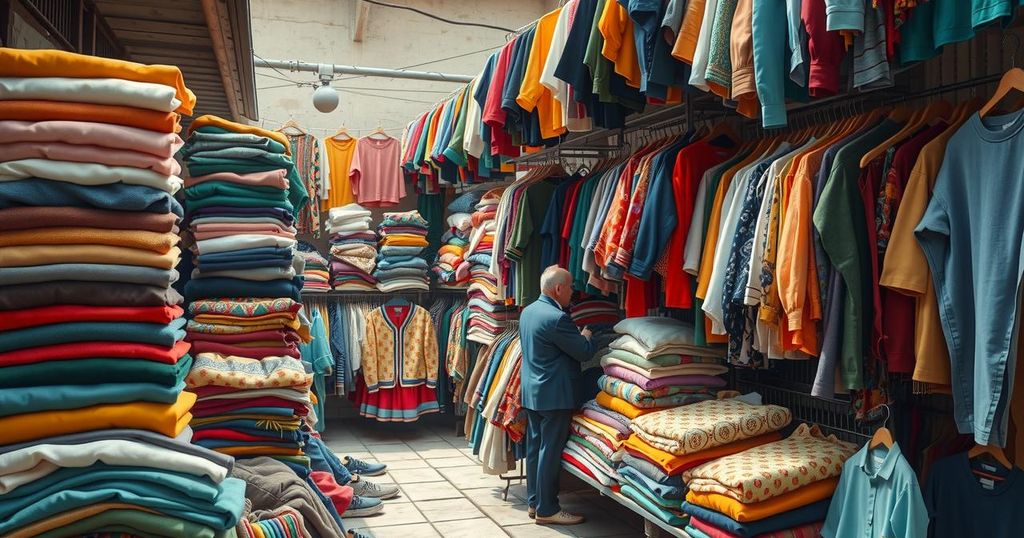Kenya has emerged as Africa’s largest importer of mitumba, with imports worth $298 million in 2023, driven by strong demand for affordable clothing. The rise in imports follows the removal of key taxes, raising concerns over the local textile industry’s viability. Neighboring countries are imposing restrictions on such imports, contrasting Kenya’s open market approach. The government’s initiatives aim to revive local textile production, even as the debate over mitumba continues to polarize policymakers.
Recent data from the Massachusetts Institute of Technology (MIT) reveals that in 2023, Kenya imported mitumba, or second-hand clothing, worth $298 million (approximately Sh38.5 billion). This figure surpasses that of Nigeria, making Kenya the largest importer of used, affordable apparel in Africa. Notably, the latest statistics show a significant increase of 12.45 percent compared to the $265 million (Sh34.28 billion) reported in 2022.
The growing demand for affordable clothing drives this rise in mitumba imports. Traders are now importing a diverse array of second-hand items, including garments and household textiles such as curtains and bedding. In contrast, neighboring countries, like Uganda and Rwanda, have implemented restrictions on the importation of used clothing to stimulate their local textile industries.
Analysis by MIT’s Observatory of Economic Complexity indicates that in 2022, Kenya’s mitumba imports were nearly equal to those of Nigeria. However, Kenya has experienced a notable surge past other African nations, primarily due to recent policy changes that have made mitumba even more affordable following the removal of Import Declaration Fees and Railway Development Levy through the Tax Laws (Amendment) Act, 2024.
The repeal of these taxes has prompted criticism from local manufacturers and officials who fear that the amendments were passed without proper consultation. There are concerns that these changes will undermine efforts to revitalize Kenya’s textile sector and facilitate competition against inexpensive second-hand clothing.
In contrast to Kenya’s open import policy, several East African Community member states have opted to enforce higher tariffs or incentivize local textile production. Currently, second-hand clothing imported from outside the EAC incurs a duty rate of 35 percent, or $0.20 per kilogram, placing additional pressure on Kenyan manufacturers.
Despite external pressures, Kenya has continued to allow large volumes of mitumba into its markets while allegedly serving as a transit hub for smuggled goods destined for neighboring countries. This situation complicates regulatory efforts, as officials suspect not all imported second-hand clothes are intended for the Kenyan market.
Kenya’s participation in the African Growth and Opportunity Act (AGOA) is closely linked to the mitumba market, as maintaining open borders for second-hand clothing is vital. Countries like Uganda and Ethiopia, which have banned mitumba imports, faced removal from AGOA, a scenario Kenya aims to avoid.
The debate surrounding the trade of second-hand clothing is contentious, with divisions among policymakers. Some view the mitumba market as essential for low-income households while others argue it jeopardizes local textile production, an industry capable of supporting millions of jobs but struggling for decades despite government intervention.
The issue of mitumba imports became politically charged during the last general election, resulting in backlash against former Prime Minister Raila Odinga when he proposed focusing on local textile production. His remarks were perceived as a threat by traders, leading him to clarify he did not intend to ban mitumba.
Efforts to improve the textile industry have included modernization initiatives, such as the renovation of Rivatex East Africa, supported by government investments. The factory is currently seeking investors to enhance its capacity amid significant competition from low-cost mitumba.
Additionally, the Kenyan government plans to implement the National Cotton, Textile, and Apparel (CTA) Policy 2024 to strengthen the local textile value chain. This policy includes proposals for establishing textile value-addition centers and enhancing existing ginneries to bolster production.
In conjunction with this economic strategy, there is an initiative to equip county industrial centers with tailoring facilities. These actions aim to promote the sector, advocate for Kenyan-made textiles, and address unfair trade practices.
In conclusion, Kenya’s mitumba market is experiencing significant growth driven by rising demand for affordable clothing and supportive policy shifts. Despite the controversy surrounding the impact of second-hand imports on local textiles, the government is implementing strategies to bolster domestic garment production. The potential effects of these policies on the economy and the livelihoods of local producers remain an ongoing concern as Kenya becomes a key player in the African second-hand clothing market.
Original Source: eastleighvoice.co.ke






